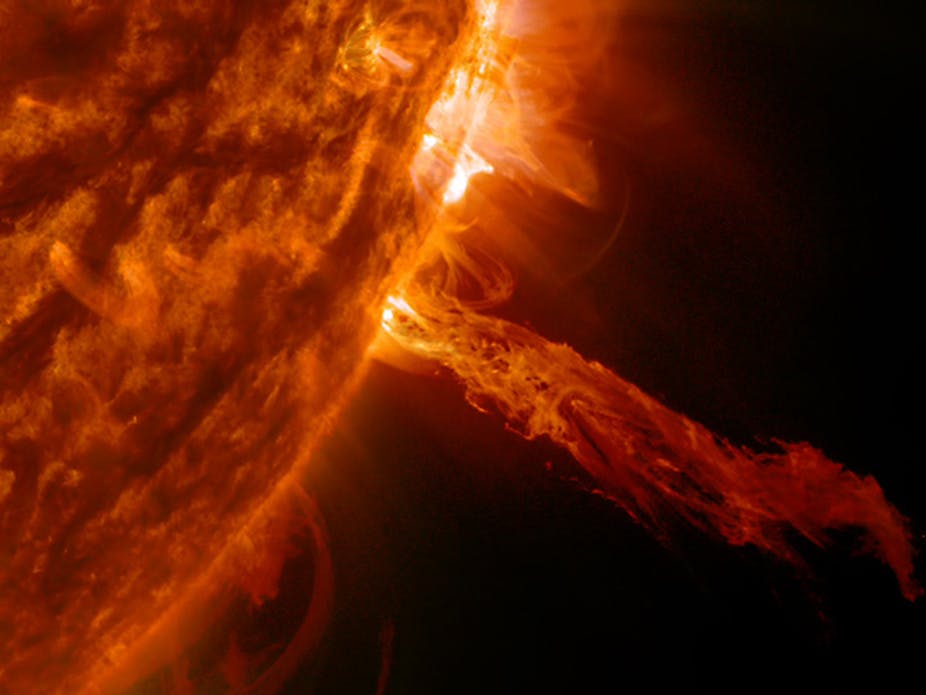Satellites are essential to modern life. So essential, in fact, that plans have been drawn up on how to cope with a situation in which we could no longer rely on them. A UK government document entitled the Space Weather Preparedness Strategy may sound strange, but when so much of modern communications, transport and the financial system relies on satellites, you can imagine why one would want a Plan B in place.
The reality is that we depend on satellites in more ways than we realise. The concept was popularised in a 1945 letter to Wireless World written by science fiction writer and inventor Arthur C Clarke – and from then satellite services has grown into an industry worth US$100 billion a year.
This highlights the extent to which satellite services pervade modern life. A fleet of several hundred communications satellites encircles our planet in geosynchronous Earth-orbit, with hundreds more at lower altitudes. Rapid satellite communications enable the global markets underpinning our economy, and the emergency and defence services that keep society safe. Satellites provide GPS global navigation services for transport on land, sea and in the air. Modern agriculture, manufacturing and logistics chains, that supply virtually everything you consume – from the milk in your coffee to the screen you’re reading this on – rely on information provided by satellites.
But you’d be forgiven for never noticing some of the subtle influences of satellite technology on your life. After all, who’d have thought that some trains use GPS data to control which doors open at platforms of different lengths? Or that banks uses high-precision timing of satellite navigation systems to time-stamp its financial transactions?

Worst case scenario
We could survive without satellites, but their influence and benefits are so widespread that it would require concerted effort and massive investment to do so. Which has led some to consider the risks satellites face, and what to do about them.
One threat is the impact of “space weather”. This can be solar flares – powerful bursts of radiation – or explosions of high-speed, high-energy protons ejected from the sun which scythe their way though near-Earth space. During periods of disturbed space weather, the region circling the Earth’s equator, the Van Allen radiation belt, swells with greater numbers of high-energy subatomic charged particles.
These can disrupt satellite operations by depositing electrical charge within the on-board electronics, triggering phantom commands or overloading and damaging sensitive components. The effects of space weather on the Earth’s upper atmosphere disrupts radio signals transmitted by navigation satellites, potentially introducing positioning errors or, in more severe cases, rendering them unusable.
These are not theoretical hazards: in recent decades, solar storms have caused outages for a number of satellites services – and a handful of satellites have been lost altogether. These were costly events – satellite operator losses have run into hundreds of millions of dollars. The wider social and economic impact was relatively limited, but even so it’s unclear how our growing amount of space infrastructure would fare against the more extreme space weather that we might face.
When space weather becomes a hurricane
The largest solar storm on record was the Carrington event in September 1859, named after the British astronomer who observed it. Of course there were no Victorian satellites to suffer the consequences, but the telegraph systems of the time were crippled as electrical currents induced in the copper wires interfered with signals, electrocuted operators and set telegraph paper alight. The geomagnetic storm it triggered was so intense that the northern lights, usually a polar phenomenon, were observed as far south as the Bahamas.
Statistical analysis of this and other severe solar storms suggests that we can expect an event of this magnitude once every few hundred years – it’s a question of “when” rather than “if”. A 2007 study estimated a Carrington event today would cause US$30 billion in losses for satellite operators and threaten vital infrastructure in space and here on the ground. It’s a risk taken sufficiently seriously that it appears on the UK National Risk Register and has led the government to draw up its preparedness programme.

We’ve only been aware of the potential damage space weather can bring for around 150 years – and have only begun to rely on technologies vulnerable to it for 50 years or so – and our understanding of it is still poor and warrants further research. It’s not surprising that engineers and insurers have invested so much effort in trying to identify the risks and recommending ways to mitigate the effects. These include building redundant electronic systems to survive overloads, signal amplifiers to cut through increased interference, super-capacitors to soak up excess electrical charges that could damage electrical or communications grids, and high-precision alternatives to satellite data such as GPS that can be used for periods when satellites cannot be contacted.
As the space weather hazard becomes better understood, it will be possible for satellite manufacturers to design and build their spacecraft to withstand most space weather. But it’s likely that improved engineering standards will be required to ensure that critical satellite systems continue to function though extreme events. In the meantime, satellite service users that need to operate during extreme space weather should plan to find ways around the outages they’d experience.

